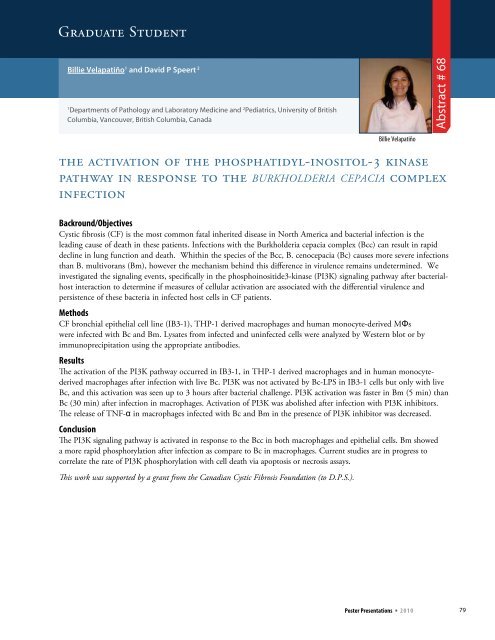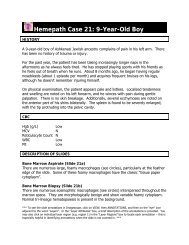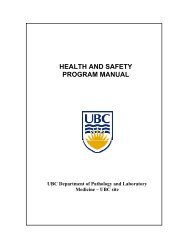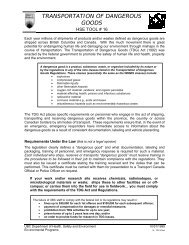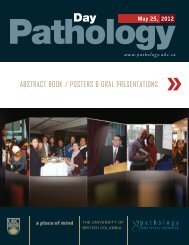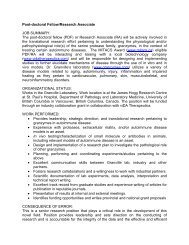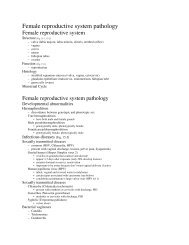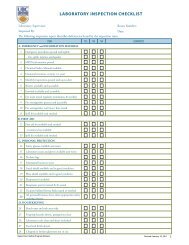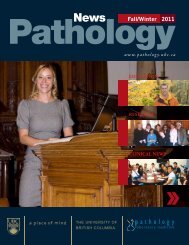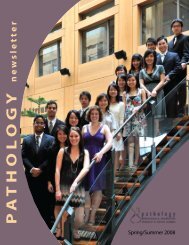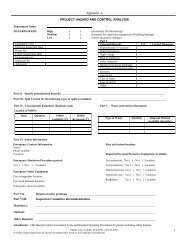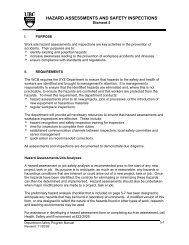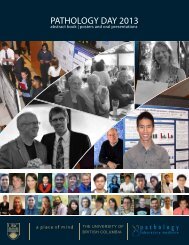Graduate StudentAbstract # 67Amal M.El-Naggar 1,2 , Cristina Tognon 2 , Fan Zhang 2 , Joan Mathers 2 , <strong>and</strong> Poul HB.Sorensen 1,21<strong>Pathology</strong> <strong>and</strong> <strong>Laboratory</strong> <strong>Medicine</strong> Department, UBC, 2 Molecular OncologyDepartment, BCCRCAmal Mohammad El-Naggary box binding protein-1 is a major contributor tosarcoma cells motility <strong>and</strong> aggressivenessBackround/ObjectivesObjectives: 1- Evaluating the effect of YB-1 knock down on sarcoma cells motility (invasion/migration). 2- Detectingthe possible relationship between YB-1 <strong>and</strong> a common marker featuring aggressiveness, hypoxia inducible factor-1alpha (HIF-1α).Background: Sarcoma are diverse group of malignant neoplasms of mesenchymal origin, commonly affecting pediatricage group <strong>and</strong> are, unfortunately, characterized by early metastatic spread, aggressive behavior <strong>and</strong> poor prognosis.Genetic alterations play an important role in sarcoma etiology. One of the genes recently believed to play a role insarcoma is Y-box binding protein-1 (YB-1). Y-box binding protein-1 (YB-1) is a member of highly conservative familyof proteins which can bind single <strong>and</strong> double str<strong>and</strong>ed DNA <strong>and</strong> single str<strong>and</strong>ed RNA so executing a control overboth transcription <strong>and</strong> translation of multitude of genes. Numerous studies pointed to the essential role of YB-1 innormal development as well as in malignant transformation. One of the well studied models demonstrating the role ofYB-1 in carcinogenesis is breast cancer. In this model, it was shown that YB-1 promotes the epithelial-mesenchymaltransition (EMT) <strong>and</strong> hence conferring the malignant cells with the aggressive features. However, very few studieshave specifically investigated the role of YB-1 in sarcoma.MethodsTC32, MG63 <strong>and</strong> RH30, representing Ewing Family Tumor (EFT), osteosarcoma (OS) <strong>and</strong> rhabdomyosarcoma(RMS), respectively were selected for the current study. The cells were treated with siCTRL or siYB-1 siRNA froma smart pool. Sarcoma Cell motility was assessed using wound healing assay <strong>and</strong> Boyden chamber migration assay.YB-1- HIF-1α relationship was assessed using hypoxia chamber incubation, immunoblotting, polysomal fractionation<strong>and</strong> real-time RT-PCR.ResultsInterference with YB-1 expression using siRNA from smart pool lead to marked reduction of sarcoma cells motility(Invasion/Migration). Another interesting finding is the intimate relation between YB-1-hypoxia- <strong>and</strong> HIF-1α.We found that, both of YB-1 <strong>and</strong> HIF-1α are induced under hypoxia. Using polysomal fractionation <strong>and</strong> qPCR,we found that YB-1 is a major translational regulator of HIF-1α. These findings may explain the role of YB-1 inpromoting the aggressiveness of sarcoma cells.Conclusion1-YB-1 strongly promotes the migration <strong>and</strong> invasion of sarcoma cells. 2- YB-1 is a major regulator of HIF-1α. 3- Bothof YB-1 <strong>and</strong> HIF-1α are upregulated by hypoxia. 4- YB-1 is very likely a step forward in underst<strong>and</strong>ing the aggressivenature of sarcoma <strong>and</strong> may represent a promising future target in treatment of this type of malignancies.78 2 0 1 0 * P o s t e r P r e s e n t a t i o n s
Graduate StudentBillie Velapatiño 1 <strong>and</strong> David P Speert 21Departments of <strong>Pathology</strong> <strong>and</strong> <strong>Laboratory</strong> <strong>Medicine</strong> <strong>and</strong> 2 Pediatrics, <strong>University</strong> of BritishColumbia, Vancouver, British Columbia, CanadaAbstract # 68Billie Velapatiñothe activation of the phosphatidyl-inositol-3 kinasepathway in response to the burkholderia cepacia complexinfectionBackround/ObjectivesCystic fibrosis (CF) is the most common fatal inherited disease in North America <strong>and</strong> bacterial infection is theleading cause of death in these patients. Infections with the Burkholderia cepacia complex (Bcc) can result in rapiddecline in lung function <strong>and</strong> death. Whithin the species of the Bcc, B. cenocepacia (Bc) causes more severe infectionsthan B. multivorans (Bm), however the mechanism behind this difference in virulence remains undetermined. Weinvestigated the signaling events, specifically in the phosphoinositide3-kinase (PI3K) signaling pathway after bacterialhostinteraction to determine if measures of cellular activation are associated with the differential virulence <strong>and</strong>persistence of these bacteria in infected host cells in CF patients.MethodsCF bronchial epithelial cell line (IB3-1), THP-1 derived macrophages <strong>and</strong> human monocyte-derived MΦswere infected with Bc <strong>and</strong> Bm. Lysates from infected <strong>and</strong> uninfected cells were analyzed by Western blot or byimmunoprecipitation using the appropriate antibodies.ResultsThe activation of the PI3K pathway occurred in IB3-1, in THP-1 derived macrophages <strong>and</strong> in human monocytederivedmacrophages after infection with live Bc. PI3K was not activated by Bc-LPS in IB3-1 cells but only with liveBc, <strong>and</strong> this activation was seen up to 3 hours after bacterial challenge. PI3K activation was faster in Bm (5 min) thanBc (30 min) after infection in macrophages. Activation of PI3K was abolished after infection with PI3K inhibitors.The release of TNF-α in macrophages infected with Bc <strong>and</strong> Bm in the presence of PI3K inhibitor was decreased.ConclusionThe PI3K signaling pathway is activated in response to the Bcc in both macrophages <strong>and</strong> epithelial cells. Bm showeda more rapid phosphorylation after infection as compare to Bc in macrophages. Current studies are in progress tocorrelate the rate of PI3K phosphorylation with cell death via apoptosis or necrosis assays.This work was supported by a grant from the Canadian Cystic Fibrosis Foundation (to D.P.S.).Poster <strong>Presentations</strong> * 2 0 1 079
- Page 2:
PathDay: Keynote Speaker (4:30 pm)T
- Page 5:
Conference Outline2010abstract #14
- Page 9 and 10:
Table of Contentabstract #57 The ro
- Page 11 and 12:
ResidentClinical SciencesArwa Al-Ri
- Page 13 and 14:
ResidentTitus Wong 1 , Marc Romney,
- Page 17 and 18:
ResidentD. Turbin 1 , D. Gao 2 , J.
- Page 19 and 20:
ResidentDavid F Schaeffer 1 , Eric
- Page 21 and 22:
ResidentMajid Zolein 1 , Daniel T.
- Page 23 and 24:
Graduate StudentAshish K. Marwaha 1
- Page 25 and 26:
Graduate StudentAmanda Vanden Hoek
- Page 27 and 28: Graduate StudentXin Ye 1 , Mary Zha
- Page 29: Graduate StudentLisa S. Ang 1 , Sar
- Page 32 and 33: Graduate StudentAbstract # 22Brian
- Page 36 and 37: OtherAbstract # 25Crystal Leung, Li
- Page 38 and 39: OtherAbstract # 27Lise Matzke 1 , W
- Page 40 and 41: Graduate StudentAbstract # 29Varun
- Page 42 and 43: Graduate StudentAbstract # 31Maite
- Page 44 and 45: Post-doctoral FellowAbstract # 33Ra
- Page 46 and 47: Graduate StudentAbstract # 35Hayley
- Page 48: Post-doctoral FellowAbstract # 37Es
- Page 51 and 52: ResidentAhmad Al-Sarraf MD 1, 2 , G
- Page 53 and 54: OtherRebecca Towle 1 , Danielle Mac
- Page 55 and 56: Graduate StudentPaul R. Hiebert 1,2
- Page 57 and 58: Graduate StudentV. Montoya 1 , J. G
- Page 59 and 60: OtherWalter Martz and Henry Kalicia
- Page 61 and 62: OtherKatelyn J. Janzen 1 , Elizabet
- Page 63 and 64: Graduate StudentJasmine L. Hamilton
- Page 65 and 66: Graduate StudentIan M. Wilson 1 , K
- Page 67 and 68: Graduate StudentKelsie L. Thu 1,3 ,
- Page 69 and 70: OtherLiat Apel-Sarid 1 , Doug Cochr
- Page 71 and 72: Graduate StudentJennifer R. Choo 1,
- Page 73 and 74: Graduate StudentEdwin S. Gershom 1
- Page 75 and 76: OtherYing Qiao 1, 2 , Chansonette H
- Page 77: Graduate StudentLeslie YM Chin 1,4
- Page 81 and 82: Graduate StudentSophie Stukas 1 , S
- Page 83 and 84: Graduate StudentKyluik DL and Scott
- Page 85 and 86: Post-doctoral FellowJoel Montane 1
- Page 87 and 88: IndexAAbozina A. 45Abraham T. 55All
- Page 89: Ye X. 27, 82Yee S. 31Yoshida E. 12Y


